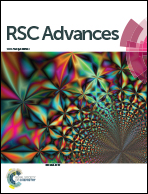Room-temperature palladium-catalysed Suzuki–Miyaura coupling of arylboric acid with aryl chlorides†
Abstract
An efficient room-temperature Pd-catalyzed Suzuki–Miyaura cross-coupling reaction of aryl-boronic acids with aryl chlorides is communicated here. The Pd(OAc)2/NiXantphos catalyst system enables the coupling reaction at room temperature in good to excellent yields (average yield >90%).


 Please wait while we load your content...
Please wait while we load your content...